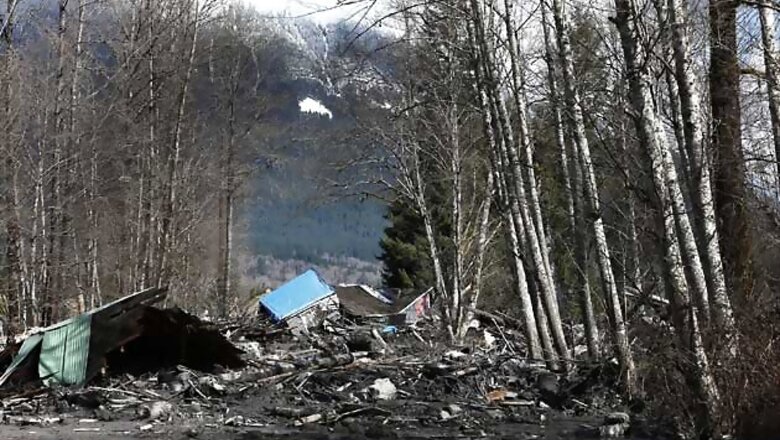
views
It is a grim step forward in the search for human remains at a mudslide that crushed a rural Washington community, but an important one: floodwaters at the site are receding, allowing crews to expand their search and yielding more human remains in areas that previously couldn't be reached. The views presented Tuesday on a media tour were chilling: shredded homes and twisted cars.
More than 10 days after a large section of a rain-soaked hill crashed down on a neighborhood in the small community of Oso, teams with cadaver dogs are still sifting through debris and soil to determine exactly how many people died in the March 22 mudslide.
The mudslide had dammed up the North Fork of the Stillaguamish River, causing water to pool. Heavy rain last week added to the flooding. But on Tuesday, the weather was dry and sunny again. With the rain stopped, at least for a few days, the floodwaters are receding, which is allowing more crews to switch from water pumping to searching.
"A lot of logjam areas, that's where we're finding human remains," search effort division supervisor Steve Harris said on Tuesday.
Here are some facts and observations in one of the worst natural disasters to hit Washington state in this century:
THE DEAD:
Officials have so far confirmed the death of 28 people. They range in age from 4-month-old Sonoah Heustis to 71-year-old Lewis F. Vandenburg. A total of 20 people are missing. They range in age from 2-year-old Brooke Sillers to Bonnie J. Gullikson, 91. Some of the missing and dead are related.
THE MUDSLIDE SITE:
From a vantage point about a mile from the collapsed hillside, the magnitude of the slide is chilling, even if only a part of it can be seen. Where there was a state highway, there's now a bed of mud and debris as much as 80 feet deep in some spots. There are few signs that a community existed here, replaced now by a field of debris of hundreds of acres. Heavy machinery is dwarfed by the mounds of mud. Crews wearing bright safety clothing trek carefully on paths made of plywood or through deep mud, using poles to assure their footing. Piles of downed trees and branches dot the brown mud field. What were houses, they're now shredded remains. Cars were pancaked and twisted.
"The mountain didn't slide like an avalanche that starts at the top and slides down. It actually blew out at the bottom. And all of that energy, because of the weight of top on it, blew across the river and brought all that water and material in it," said Lt. Richard Burke, a firefighter and incident spokesman.
The valley then channeled the slide like a bowl.
He added: "Like a big soup bowl, it kind of sloshed up the bank and came back down."
Nothing has yet been removed from the field. The debris is contaminated with remains of septic tanks and other "contaminants" found in cars and garages. Crews have begun piling up trees and house items in different sections, Burke added.
Said Harris: "Cars and propane tanks and all the things people have around their homes is in the debris mix. There's stuff buried there - think about all the stuff that's around your house. It's very likely it (a lot of the stuff) won't be recovered. It's just buried there."
THE SEARCH FOR HUMAN REMAINS:
Crews are being careful in their search for human remains. Harris said boats with sonar are among the pieces of equipment put to use. Crews are "trying to use every tool we can find and think of," he said. "Everything moved so much across the landscape, where we find logs and debris is where we're going to find (remains)."
The weather helped Tuesday. It was sunny and dry, a stark contrast to the first few days of the recovery operations when a significant percentage of rescue crew members had to focus on de-flooding the area. There were 270 tactical personnel and volunteers present.
"We've been able to channel the water. We got less folks controlling the water and more folks with their hands on the ground. And that's what we need," said Burke.
The search is painstaking. In expanding their area, crews are using a grid system. But despite the progress, there are parts of the debris field that have not been examined because they are not yet stable.
"We've had excavator operators that have been out here every day that are used to moving tens of thousands of yards of material that are moving handful of materials with these huge buckets," said Burke. "Then people come in behind them with hand tools."
The rain, though, is forecast to come back. As much as 3 inches of rain are expected to fall between Thursday and Sunday.
FINANCIAL COSTS:
Washington Gov. Jay Inslee says the mudslide caused about $10 million in damage to homes destroyed in the slide area and their contents. He estimates further costs of $32.1 million for search and recovery efforts, and to remove all the debris. But he says the costs could go higher.


















Comments
0 comment